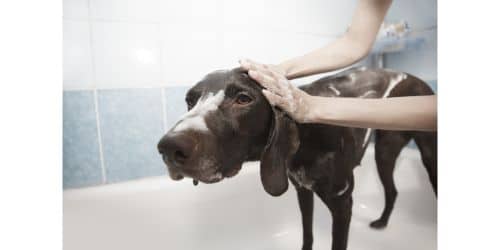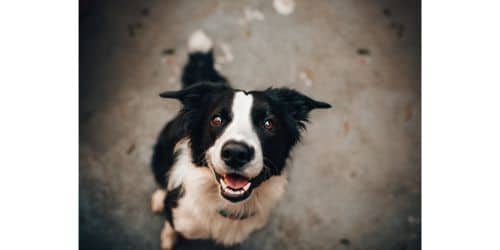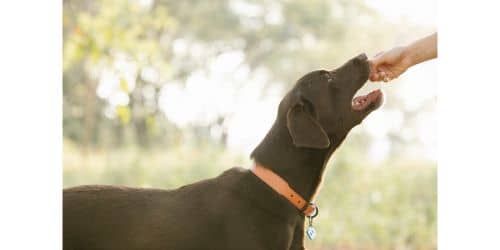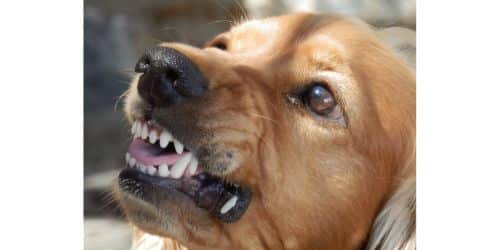You want the best for your pet, including their grooming routine, as a pet owner. When it comes to bathing your dog, you may be wondering if using baby shampoo is a good idea. We delve into the fascinating realm of canine grooming in this blog post to answer the burning question: Can I use baby shampoo on my dog? Join us as we investigate the advantages, disadvantages, and factors to consider while choosing the best shampoo for your canine pet.
Understanding Canine Skin and Coat
Before entering the realm of shampoos, it’s critical to grasp the differences between a dog’s skin and coat. Canine skin differs from human skin in terms of pH balance and composition. Dogs have alkaline skin, whereas humans have acidic skin. Furthermore, the coat structure of dogs varies from breed to breed. These distinctions are critical in identifying the sort of shampoo that is appropriate for use on your dog.
Understanding Baby Shampoo
Baby shampoo is specially intended for infants and young children, and it is gentle on their sensitive skin and hair. These shampoos are typically hypoallergenic, free of harsh ingredients, and have a pH balance that is appropriate for infants.
Baby shampoo is specially formulated for infants’ sensitive skin and fragile hair. It is designed to be mild, tearless, and hypoallergenic. Because of the gentle nature of baby shampoo, several pet owners have considered putting it on their pets. However, it’s critical to look at the contents, pH balance, and potential hazards before you use baby shampoo on dogs.
Ingredients Matter
Ingredients are important when it comes to selecting the best shampoo for your dog. Mild surfactants, moisturizers, and scents are generally found in baby shampoos. While these components may be safe for human newborns, they may not be appropriate for a dog’s skin and coat. Certain components can be more irritating to dogs, and other additives present in infant shampoos, such as scents or colors, may cause skin irritations or allergic responses.
pH Balance Considerations
As previously stated, dogs have a higher alkaline pH balance in their skin than humans. Baby shampoos are designed to complement the more acidic pH of human skin. Using a lower-pH baby shampoo on dogs may upset their skin’s natural pH balance, perhaps causing dryness, irritation, or inflammation. It is critical to use a dog shampoo that is specifically made to preserve the proper pH balance for dog skin.
Skin Sensitivity and Allergies
Skin sensitivity and allergies can vary in severity in dogs, just like in humans. Certain components in infant shampoos may cause skin irritations or allergic reactions in some dogs. It is critical to be aware of your dog’s specific sensitivity and to speak with a veterinarian.
The Benefits of Baby Shampoo for Dogs
Using baby shampoo on your dog might provide various advantages. While there are certain risks to using baby shampoo on dogs, there are also some advantages to consider. Let’s look at some of the benefits of using baby shampoo on your pet:
#1. Mild and Gentle Formulation:
Baby shampoos are designed to be delicate and mild, making them an excellent choice for dogs with sensitive skin or allergies. The mildness of baby shampoo can help reduce the risk of skin irritation or allergic reactions, ensuring that your pet has a pleasant washing experience.
#2. Tear-Free Formula:
One of the most noticeable advantages of baby shampoo is that it is usually tear-free. This means that if shampoo gets in your dog’s eyes when bathing, it is less likely to cause stinging or pain. This function can make bathing your dog less stressful for both of you.
#3. Pleasant Fragrance:
Baby shampoos are frequently scented, leaving your dog smelling fresh and clean after a bath. While dogs have their own natural scent, using a lightly scented baby shampoo will help conceal any undesirable odors your dog may have picked up, leaving them feeling wonderful.
#4. Affordability and Availability:
Baby shampoo is commonly available and reasonably priced in most supermarkets and pharmacies. It is easy to buy and might be a low-cost alternative for dog owners seeking a low-cost grooming solution that nevertheless gives a satisfying washing experience.
#5. Multi-Purpose Use:
In addition to bathing your dog, Baby Shampoo can be used for other grooming requirements. It can be used to clean specific areas or as a gentle facial cleanser for dogs with wrinkles or folds. The gentle formulation makes it suited for a variety of cleaning tasks, giving pet owners flexibility.
#6. Compatibility with Certain Skin Conditions:
Veterinarians may recommend baby shampoo in some circumstances for dogs with particular skin issues. If your dog has a skin issue that demands careful cleansing, baby shampoo may be an appropriate option. However, before using baby shampoo for any specific skin issues, speak with your veterinarian.
While these advantages make baby shampoo appear to be a reasonable alternative for bathing your dog, it is vital to measure them against the potential hazards and assess your pet’s unique needs. Every dog is different, and what works for one might not work for another.
If you must use baby shampoo on your dog, consider one that is fragrance-free and hypoallergenic. After each bath, always check your dog’s skin and coat to ensure there are no bad reactions. If you see any signs of dryness, itching, or irritation, stop using baby shampoo and consult your veterinarian about alternate grooming choices.
Considerations When Using Baby Shampoo on Dogs
While baby shampoo may appear to be a good choice for dogs, there are a few things to consider. The pH differential between human and canine skin is a critical aspect. Dogs’ skin pH is higher, often ranging from 6.2 to 7.5. Baby shampoos, on the other hand, contain a pH level that is closer to that of human skin, ranging between 4.5 and 6.5. This change in pH levels may affect your dog’s natural protective barrier.
Potential Risks of Using Baby Shampoo on Dogs
While baby shampoo is generally gentle and moderately effective, there are certain risks associated with using it on dogs. It’s critical to be aware of these hazards to make an informed decision about whether they’re appropriate for your pet. Consider the following potential risks:
#1. Disruption of pH Balance:
Dogs have a higher skin pH than humans. Baby shampoos are designed to match the pH levels of human skin, which might vary greatly from the pH level of a dog’s skin. Using a shampoo with a pH level that is incompatible with your dog’s skin might upset the natural equilibrium, resulting in dryness, itching, or skin irritation.
#2. Natural Oils Stripping:
The skin of a dog produces natural oils that aid in the maintenance of a healthy coat as well as the protection of the skin. Because baby shampoos are mild and delicate, they may not effectively cleanse a dog’s skin of the oils that have accumulated. Using baby shampoo too regularly or for a lengthy period, on the other hand, can take away these natural oils, leaving the skin dry and prone to irritation.
#3. Additives and Fragrances:
Some infant shampoos contain scents, colors, or other chemicals that can irritate the sensitive skin of a dog. Certain chemicals that people may tolerate well may cause allergies or sensitivities in dogs. It is critical to read the label and avoid purchasing baby shampoos that include additional scents or harsh chemicals that may cause skin sensitivities.
#4. Insufficient flea control:
Baby shampoos are not designed to kill fleas or ticks. If your dog has a flea or tick infestation, utilizing baby shampoo alone may not be beneficial. To preserve your dog’s health, use appropriate flea and tick control products advised by your veterinarian.
#5. Allergic Reactions:
Even though infant shampoos are generally mild and hypoallergenic, certain components may cause allergic reactions in some dogs. Because each dog’s skin is different, what works for one may not work for another. Before putting any new product on your dog’s entire body, always perform a patch test to check for any adverse effects.
#6. Eye and Ear Sensitivities:
Baby shampoos are made to be tear-free and gentle on the eyes of babies. Dogs, on the other hand, have differing visual and ear sensitivities. Using baby shampoo near your dog’s eyes or ears can still cause irritation or pain. It’s critical to prevent getting shampoo in your dog’s eyes or ears during bath time.
Consider using grooming products designed specifically for dogs to reduce these potential dangers. These solutions are created to meet the specific demands of a dog’s skin and coat, while also keeping a healthy pH balance and offering optimal care.
Remember, if you notice any adverse reactions or changes in your dog’s skin or behavior after using baby shampoo, discontinue its use immediately and consult with your veterinarian for further guidance.
Alternatives to Baby Shampoo for Dogs
If you do not want to use baby shampoo on your dog, there are canine-specific grooming solutions available. Dog shampoos are created to address the specific demands of a dog’s skin and coat. These shampoos frequently have a balanced pH level and incorporate chemicals that address certain skin issues or coat types in dogs. Consultation with your doctor or a professional groomer can assist you in selecting the best dog shampoo for your pet.
#1. Moisturizing Shampoos for Dogs
Consider shampoos with moisturizing characteristics while shopping for your dog. These shampoos help your dog’s skin retain its natural oils, reducing dryness and irritation. Look for components that are known to soothe and nourish the skin, such as oatmeal, aloe vera, or coconut oil.
#2. Hypoallergenic Shampoos for Dogs
Hypoallergenic shampoos can be a good alternative to baby shampoo if your dog has sensitive skin or allergies. These shampoos are designed to reduce the likelihood of adverse responses and frequently contain natural components that are soft on the skin.
#3. Medicated Dog Shampoos
Medicated shampoos prescribed by a veterinarian may be necessary for dogs with specific skin diseases such as dermatitis or fungal infections. These shampoos are designed to target and treat the underlying problem while also washing the skin and coat.
#4. Natural and Organic Dog Shampoos
There are various possibilities if you wish to use natural or organic products on your dog. Natural and organic shampoos are often made from plant-based materials and do not contain harsh chemicals, making them a safe alternative for your pet.
#5. Specialized Shampoos for Different Coat Types
Different breeds of dogs have different coat types, such as short, long, curly, or double coats. Using a shampoo formulated specifically for your dog’s coat type will help maintain its health and appearance. These shampoos frequently include chemicals that increase coat gloss, manageability, and shedding reduction.
Bathing Frequency for Dogs
Regardless of the shampoo you use, it is critical to consider your dog’s bathing frequency. While frequent bathing is vital for cleanliness, over-bathing can deplete your dog’s skin of natural oils, causing dryness and irritation. Bathing frequency should be determined by criteria such as your dog’s breed, coat type, and activity level. Consultation with your veterinarian or groomer can assist in determining the optimal bathing routine for your pet.
Proper Bathing Techniques for Dogs
Bathing practices must be followed to provide a successful bathing experience for both you and your dog. Begin by thoroughly soaking your dog’s coat, avoiding sensitive regions such as the eyes and ears. Apply the shampoo of choice, lather gently, and then completely rinse to remove all shampoo residue. To avoid excessive wetness on the skin, towel dry your dog or use a pet dryer in a low-heat setting after bathing.
What is the best way to bathe a dog with baby shampoo?
Bathing a dog with baby shampoo requires a careful and gentle approach. Here’s a step-by-step guide on the best way to bathe your dog using baby shampoo:
- Prepare the Bathing Area
- Gather Supplies
- Brush Your Dog
- Adjust the Water Temperature
- Wet Your Dog
- Apply Baby Shampoo
- Massage and Cleanse
- Rinse Thoroughly
- Dry Your Dog
- Reward and Praise
What are some natural alternatives to baby shampoo for dogs?
If you’re looking for natural alternatives to baby shampoo for dogs, there are several options you can consider. These alternatives utilize natural ingredients and are often milder and gentler on a dog’s skin. Here are some natural alternatives for bathing your dog:
- Oatmeal Shampoo
- Aloe Vera Shampoo
- Coconut Oil Shampoo
- Chamomile Shampoo
- Herbal Shampoos
Conclusion
While baby shampoo may appear to be a mild alternative for bathing your dog, it is crucial to remember the pH levels of human and canine skin. Because of the risks of using baby shampoo, such as altering the natural oils and causing dryness or irritation, it is best to look into alternatives designed exclusively for dogs.
Dog shampoos, which come in moisturizing, hypoallergenic, medicinal, natural, and specialized varieties, offer more targeted treatment for your pet’s specific needs. Consulting with professionals and using suitable bathing procedures will provide a pleasurable bathing experience and boost your pet’s overall well-being.
Remember that your dog’s health and comfort should always come first, so use grooming products that are both safe and effective for their individual needs. You can keep your dog’s coat clean, healthy, and vibrant by investing in the right shampoo and following proper bathing practices.
Related Articles
- ORAL FLEA TREATMENT FOR CATS
- DIY Homemade Dog Anti Itch Spray
- Dog Shampoo For Dry Skin
- GRASS ALLERGY IN DOGS: Causes, Symptoms. And Treatment
- What is a Flea Dirt & How To Get Rid Of It






